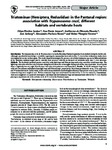Use este identificador para citar ou linkar para este item:
http://www.alice.cnptia.embrapa.br/alice/handle/doc/1029652Registro completo de metadados
| Campo DC | Valor | Idioma |
|---|---|---|
| dc.contributor.author | SANTOS, F. M. | pt_BR |
| dc.contributor.author | JANSEN, A. M. | pt_BR |
| dc.contributor.author | MOURAO, G. | pt_BR |
| dc.contributor.author | JURBERG, J. | pt_BR |
| dc.contributor.author | NUNES, A. P. | pt_BR |
| dc.contributor.author | HERERRA, H. M. | pt_BR |
| dc.date.accessioned | 2015-11-26T11:11:11Z | pt_BR |
| dc.date.available | 2015-11-26T11:11:11Z | pt_BR |
| dc.date.created | 2015-11-26 | pt_BR |
| dc.date.issued | 2015 | pt_BR |
| dc.identifier.citation | Revista da Sociedade Brasileira de Medicina Tropical, v. 48, n. 5, sep/oct, p.532-538, 2015. | pt_BR |
| dc.identifier.uri | http://www.alice.cnptia.embrapa.br/alice/handle/doc/1029652 | pt_BR |
| dc.description | The transmission cycle of Trypanosoma cruzi in the Brazilian Pantanal region has been studied during the last decade. Although considerable knowledge is available regarding the mammalian hosts infected by T. cruzi in this wetland, no studies have investigated its vectors in this region. This study aimed to investigate the presence of sylvatic triatomine species in different habitats of the Brazilian Pantanal region and to correlate their presence with the occurrences of vertebrate hosts and T. cruzi infection. Methods: The fieldwork involved passive search by using light traps and Noireau traps and active search by visual inspection. The light traps were placed at five selected points along forested areas for seven nights during each of the nine excursions. At each point where a light trap was set, eight Noireau traps were placed in palm trees and bromeliads. Results: In all, 88 triatomine bugs were collected: two and one individuals from light traps and Noireau traps, respectively; three from peridomestic areas; 23 in coati nests; and 59 in thornbird nests. In this study, active search in microhabitats showed higher efficiency than passive search, since 95% of the triatomine bugs were caught in nests. Further, triatomine bugs were only found to be infected by T. cruzi in coati nests. Conclusions: Coati nests might act as a point of convergence and dispersion for triatomine bugs and mammal hosts infected by T. cruzi, thereby playing an important role in the sylvatic cycle of T. cruzi in the Pantanal region. | pt_BR |
| dc.language.iso | eng | eng |
| dc.rights | openAccess | eng |
| dc.subject | Phacellodomus sp Triatominae | pt_BR |
| dc.subject | Coati | pt_BR |
| dc.subject | Parasita | pt_BR |
| dc.subject | Host-parasite relationship | pt_BR |
| dc.title | Triatominae (Hemiptera, Reduviidae) in the Pantanal region: association with Trypanosoma cruzi, different habitats and vertebrate hosts. | pt_BR |
| dc.type | Artigo de periódico | pt_BR |
| dc.date.updated | 2017-07-25T11:11:11Z | pt_BR |
| dc.subject.thesagro | Parasito | pt_BR |
| dc.subject.nalthesaurus | Nasua nasua | pt_BR |
| dc.subject.nalthesaurus | wetlands | pt_BR |
| riaa.ainfo.id | 1029652 | pt_BR |
| riaa.ainfo.lastupdate | 2017-07-25 | pt_BR |
| dc.identifier.doi | 10.1590/0037-8682-0184-2015 | pt_BR |
| dc.contributor.institution | FILIPE MARTINS SANTOS, UCDB; ANA MARIA JANSEN, FIOCRUZ; GUILHERME DE MIRANDA MOURAO, CPAP; JOSÉ JURBERG, FIOCRUZ; ALESSANDRO PACHECO NUNES, UFMS; HEITOR MIRAGLIA HERRERA, UCDB. | pt_BR |
| Aparece nas coleções: | Artigo em periódico indexado (CPAP)  | |
Arquivos associados a este item:
| Arquivo | Descrição | Tamanho | Formato | |
|---|---|---|---|---|
| FilipeTriatominae.pdf | 3,32 MB | Adobe PDF |  Visualizar/Abrir |









